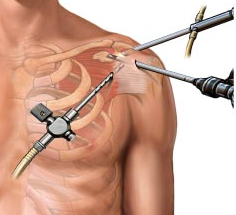Shoulder instability means the shoulder joint is not stable, and slides around too much in the socket. For some patients, the unstable shoulder slips out of the socket, which is caused subluxation. If left untreated, shoulder instability leads to shoulder joint arthritis.
What parts of the shoulder are affected by instability?
The shoulder is made of three main bones: the upper arm bone (humerus), the shoulder blade (scapula), and the  collarbone (clavicle). The rotator cuff consists of muscles and tendons that connect the bones together. The glenoid joint is the part of the scapula that makes up the shoulder socket.
collarbone (clavicle). The rotator cuff consists of muscles and tendons that connect the bones together. The glenoid joint is the part of the scapula that makes up the shoulder socket.
A rim of soft tissue (labrum) surrounds the glenoid, and the joint is surrounded by a watertight sac called the joint capsule. The walls of this capsule are made up of ligaments, which attach bones to bones. When these ligaments are stretched or torn, it causes instability.
What causes shoulder instability?
Shoulder instability usually follows some type of dislocation injury, and that initial injury is reduced manually (put back in the socket). The shoulder may return to normal, but remains unstable due to stressed, torn, or strained labrum and ligaments. In addition, the unstable shoulder may dislocate during usual activities.
Some patients may have an unstable shoulder without a history of previous dislocation. This is often the case with volleyball players, baseball pitchers, swimmers, and other athletes. When the joint capsule stretches out and muscles weaken, the humerus head can slip around too much in the joint.
What are the symptoms of shoulder instability?
Chronic shoulder instability can cause:
- Frequent subluxation – The shoulder feels loose and slips in certain positions. This often occurs when the hand is raised over the head while throwing. Symptoms occurring with subluxation are pain, a feeling of slipping, pinching, and numbness.
- Frequent dislocations – With instability there is a risk for dislocation. This is very painful, and the shoulder looks deformed.
- Nerve damage – When frequent subluxation or dislocations occur, the nerves around the shoulder joint can become stretched. This can cause numbness on the arm, just below the top of the shoulder.
How is shoulder instability diagnosed?
The Phoenix shoulder specialist will diagnose shoulder instability by your medical history and physical examination. The  doctor asks questions about your shoulder injuries, your pain levels, and the ways the symptoms affect your usual activities. The doctor will check for mobility and strength, testing the ligaments. X-rays are used to confirm that the shoulder was previously injured or dislocated.
doctor asks questions about your shoulder injuries, your pain levels, and the ways the symptoms affect your usual activities. The doctor will check for mobility and strength, testing the ligaments. X-rays are used to confirm that the shoulder was previously injured or dislocated.
The Arizona orthopedic surgeon may choose to perform an arthroscopic test while you are under general anesthesia. The small camera is inserted into the shoulder through a tiny incision, which allows the doctor to view ligaments and muscles.
How is shoulder instability treated?
The orthopedic shoulder surgeon in Arizona may choose to prescribe pain medications for your injury. Hands-on treatments by a therapist include exercises used to improve range of motion and strengthen muscles. These strengthening exercises help with rotator cuff control and shoulder blade muscle action.
Will I need shoulder surgery?
If medications and physical therapy does not stabilize your shoulder, you may require surgery. These procedures are used to tighten loose ligaments to give the shoulder more security. Surgery is performed using arthroscopy techniques and few complications exist. After surgery, recovery takes between 4-6 months. The Arizona orthopedic surgeon will give you recommendations on what activities are permitted following the procedure.
Dr. Adam Farber at Phoenix Shoulder and Knee is a top specialist in the Valley for helping with your shoulder pain. Procedures are performed in a minimally invasive fashion, and most insurance is accepted. Call today!



